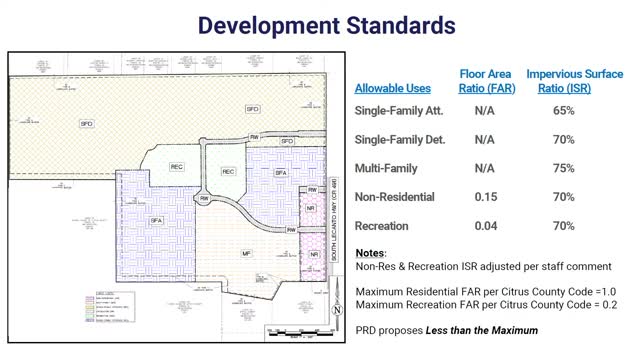Developers propose ambitious open space plan for Citrus County
August 02, 2024 | Citrus County, Florida

This article was created by AI summarizing key points discussed. AI makes mistakes, so for full details and context, please refer to the video of the full meeting. Please report any errors so we can fix them. Report an error »

During a recent government meeting, discussions centered on a proposed Planned Unit Development (PUD) project in Citrus County, highlighting the shift towards smaller lot sizes and the integration of open spaces within the community design. The project aims to enhance recreational opportunities, featuring proposed active trails and fields, while maintaining a significant amount of open space—approximately 40% of the 206 acres designated for development.
Key points included the clarification of buffer requirements between residential and non-residential areas. The developers acknowledged a misunderstanding regarding the necessary buffer sizes, committing to adhere to the code requirements and even exceed them in sensitive areas. The project plans to implement a 15-foot buffer between multifamily units and non-residential properties, with intentions to adjust this to a type C buffer as per staff recommendations.
Concerns were raised regarding parking solutions, particularly the use of parallel parking to accommodate visitor needs in smaller lot developments. While the developers advocated for this practice as a modern solution to parking challenges, staff and some commissioners expressed reservations, indicating that they would not require parallel parking in the project.
The meeting also touched on signage regulations, with developers seeking permission for signs at key entry points and within non-residential areas. However, there were concerns about the placement of these signs within required buffer zones along Lecanto Highway.
Overall, the meeting underscored the developers' commitment to complying with local regulations while promoting a community-oriented design that prioritizes open space and recreational facilities. The project is positioned as a response to the growing trend of smaller lot developments across Florida, aiming to balance residential needs with environmental considerations.
Key points included the clarification of buffer requirements between residential and non-residential areas. The developers acknowledged a misunderstanding regarding the necessary buffer sizes, committing to adhere to the code requirements and even exceed them in sensitive areas. The project plans to implement a 15-foot buffer between multifamily units and non-residential properties, with intentions to adjust this to a type C buffer as per staff recommendations.
Concerns were raised regarding parking solutions, particularly the use of parallel parking to accommodate visitor needs in smaller lot developments. While the developers advocated for this practice as a modern solution to parking challenges, staff and some commissioners expressed reservations, indicating that they would not require parallel parking in the project.
The meeting also touched on signage regulations, with developers seeking permission for signs at key entry points and within non-residential areas. However, there were concerns about the placement of these signs within required buffer zones along Lecanto Highway.
Overall, the meeting underscored the developers' commitment to complying with local regulations while promoting a community-oriented design that prioritizes open space and recreational facilities. The project is positioned as a response to the growing trend of smaller lot developments across Florida, aiming to balance residential needs with environmental considerations.
View full meeting
This article is based on a recent meeting—watch the full video and explore the complete transcript for deeper insights into the discussion.
View full meeting